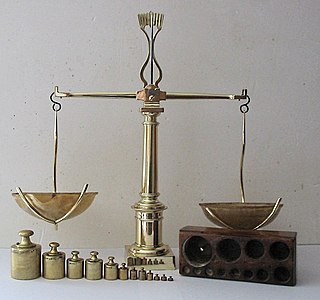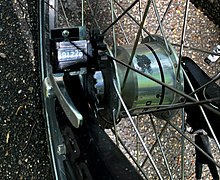In digital logic and computing, a counter is a device which stores the number of times a particular event or process has occurred, often in relationship to a clock. The most common type is a sequential digital logic circuit with an input line called the clock and multiple output lines. The values on the output lines represent a number in the binary or BCD number system. Each pulse applied to the clock input increments or decrements the number in the counter.

An odometer or odograph is an instrument used for measuring the distance traveled by a vehicle, such as a bicycle or car. The device may be electronic, mechanical, or a combination of the two (electromechanical). The noun derives from ancient Greek ὁδόμετρον, hodómetron, from ὁδός, hodós and μέτρον, métron ("measure"). Early forms of the odometer existed in the ancient Greco-Roman world as well as in ancient China. In countries using Imperial units or US customary units it is sometimes called a mileometer or milometer, the former name especially being prevalent in the United Kingdom and among members of the Commonwealth.

A tachometer is an instrument measuring the rotation speed of a shaft or disk, as in a motor or other machine. The device usually displays the revolutions per minute (RPM) on a calibrated analogue dial, but digital displays are increasingly common.

A speedometer or speed meter is a gauge that measures and displays the instantaneous speed of a vehicle. Now universally fitted to motor vehicles, they started to be available as options in the early 20th century, and as standard equipment from about 1910 onwards. Other vehicles may use devices analogous to the speedometer with different means of sensing speed, eg. boats use a pit log, while aircraft use an airspeed indicator.

A racing bicycle, also known as a road bike is a bicycle designed for competitive road cycling, a sport governed by and according to the rules of the Union Cycliste Internationale (UCI).
Cycle sport is competitive physical activity using bicycles. There are several categories of bicycle racing including road bicycle racing, cyclo-cross, mountain bike racing, track cycling, BMX, and cycle speedway. Non-racing cycling sports include artistic cycling, cycle polo, freestyle BMX, mountain bike trials, hardcourt bike polo and cycleball. The Union Cycliste Internationale (UCI) is the world governing body for cycling and international competitive cycling events. The International Human Powered Vehicle Association is the governing body for human-powered vehicles that imposes far fewer restrictions on their design than does the UCI. The UltraMarathon Cycling Association is the governing body for many ultra-distance cycling races.

A scale or balance is a device used to measure weight or mass. These are also known as mass scales, weight scales, mass balances, massometers, and weight balances.

In various contexts of science, technology, and manufacturing, an indicator is any of various instruments used to accurately measure small distances and angles, and amplify them to make them more obvious. The name comes from the concept of indicating to the user that which their naked eye cannot discern; such as the presence, or exact quantity, of some small distance.

Gear inches is an imperial measure corresponding to the diameter in inches of the drive wheel of a penny-farthing bicycle with equivalent (direct-drive) gearing. A commonly used metric alternative is known as metres of development or rollout distance, which specifies how many metres a bicycle travels per revolution of the crank.

A cyclocomputer, cycle computer, cycling computer or cyclometer is a device mounted on a bicycle that calculates and displays trip information, similar to the instruments in the dashboard of a car. The computer with display, or head unit, usually is attached to the handlebar for easy viewing. Some GPS watches can also be used as display.

This is a glossary of terms and jargon used in cycling, mountain biking, and cycle sport.

Mountain bike racing is the competitive cycle sport discipline of mountain biking held on off-road terrain. The Union Cycliste Internationale (UCI) recognised the discipline relatively late in 1990, when it sanctioned the world championships in Durango, Colorado. The first UCI Mountain Bike World Cup series took place in 1988. Its nine-race circuit covered two continents—Europe and North America—and was sponsored by Grundig. Cross-country racing was the only World Cup sport at this time. In 1993, a six-event downhill World Cup was introduced. In 1996, cross-country mountain biking events were added to the Olympic Games. In 2006, cross-country mountain biking events became part of the World Deaf Cycling Championships for the first time in San Francisco, USA.

Ted Corbitt was an American long-distance runner. The first African-American to run the marathon at the Summer Olympics and the founding president of New York Road Runners, Corbitt is often called "the father of American long distance running." He was also an ultramarathon pioneer, helping to revive interest in the sport in the United States in the 1960s and 1970s. New York Times columnist Robert Lipsyte called Corbitt a "spiritual elder of the modern running clan". In a Runner's World feature honoring lifetime achievement, writer Gail Kislevitz called Corbitt a "symbol of durability and longevity". Corbitt was among the first five runners to be inducted into the National Distance Running Hall of Fame, and the first to be inducted into the American Ultrarunning Hall of Fame.

A hubometer or hubodometer, is a device mounted on the axle of any land vehicle to measure the distance traveled by a vehicle based on the rotations of the wheel hub.

Cross-country (XC) cycling is a discipline of mountain biking. Cross-country cycling became an Olympic sport in 1996 and is the only form of mountain biking practiced at the Olympics.

Mechanical counters are counters built using mechanical components. They typically consist of a series of disks mounted on an axle, with the digits zero through nine marked on their edge. The right most disk moves one increment with each event. Each disk except the left-most has a protrusion that, after the completion of one revolution, moves the next disk to the left one increment. Such counters have been used as odometers for bicycles and cars and in tape recorders and fuel dispensers and to control manufacturing processes. One of the largest manufacturers was the Veeder-Root company, and their name was often used for this type of counter. Mechanical counters can be made into electromechanical counters, that count electrical impulses, by adding a small solenoid.
The Association of International Marathons and Distance Races, also known as AIMS, is an association of the organisers of long-distance road running races. It was founded in 1982 at a meeting in London of marathon race directors. Its membership was extended in 1986 to include all road races. In June 2016, over 400 race organisations were members.
The short course prevention factor (SCPF) is a multiplicative factor or coefficient used in the sport of athletics, specifically road running, to ensure that the measured length of a course is at least as long as the desired length of the course. World Athletics, the international governing body for athletics, as well as USA Track & Field, the national governing body for the United States, specify the numerical factor of the SCPF to be 1.001. The SCPF has important implications when verifying world record performances.

The Manchester Marathon is a long-distance running event in Greater Manchester, England. It was known as the Greater Manchester Marathon until the word "Greater" was dropped beginning with the (cancelled) 2020 edition of the race. The most recent marathon was held on 14 April 2024, and finished at Old Trafford Cricket Ground. The race was first held in 2012. It is claimed that the race is the flattest marathon course in the UK, with only 54 metres (177 ft) of elevation. The 2013, 2014 and 2015 Greater Manchester Marathon times have been declared invalid after the course was found to be 380 m (1,250 ft) too short.

















